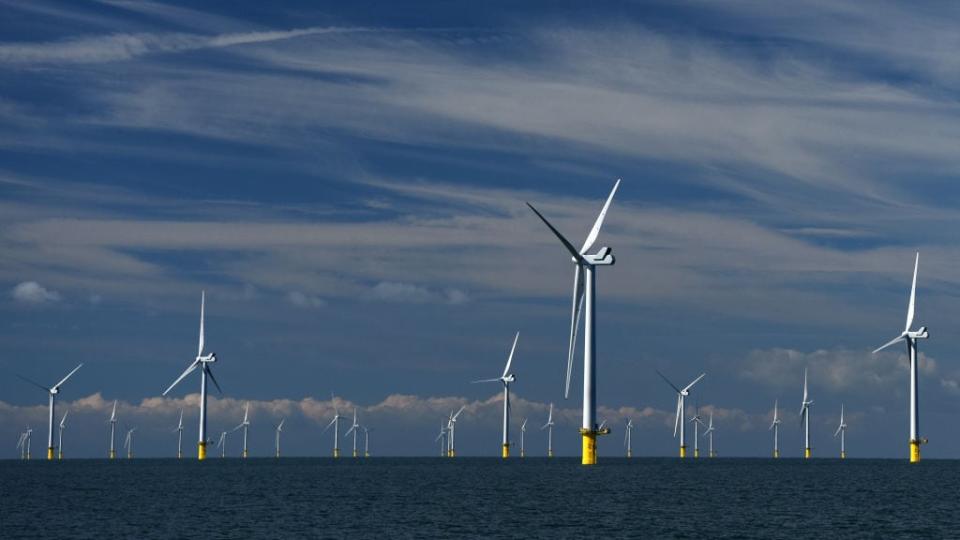Too much confusion and not enough info about offshore wind project proposals, says union rep


Katie Power, Fish, Food & Allied Workers-Unifor's energy industry liaison, is raising concerns about how offshore wind farms could impact the fishery. (Submitted by Katie Power)
A representative of Newfoundland and Labrador's largest fisheries union says she's concerned about the potential impact of offshore wind farms on the fishery — and says the public hasn't been given enough information.
Katie Power, energy industry liaison for Fish, Food & Allied Workers-Unifor, has been attending public meetings about the possibility of wind farms popping up off Newfoundland's coast. The fishing industry has a particular interest in potential development, she said.
"The fishing industry serves to be one of the most vulnerable industries and will without a doubt be faced with the most adverse impacts to offshore wind. So we have particular interest in this file," Power recently told CBC News.
The Regional Assessment of Offshore Wind Development is an independent group appointed by the federal and provincial governments to collect information on the feasibility of offshore wind in the province.
The committee has hosted virtual meetings and recently started hosting in-person meetings in the province to hear the public and stakeholder's concerns.
Power said she's attended some of the meetings, both virtually and in person. A lot of meeting time is spent clarifying the group's intent, who they are, what they're doing and what they'll do with their findings, she said. She said she thinks the committee is spending so much time reintroducing themselves because their objectives haven't been adequately explained to people.
"Until this point, it really hasn't been adequately articulated to, say, myself as a member within the industry, but of course also to stakeholders and members of the public, who should have a pretty clear understanding of who they are at this point."
The federal government is expected to make an announcement on offshore renewable energy in Newfoundland and Labrador on Wednesday.

The Regional Assessment of Offshore Wind Development committee is hosting public meetings to gather information from the public on potential wind farms. (Mike Hewitt/Getty Images)
Power says there's a lack of transparency over where future wind farms could be located, their size, and would they they would be floating or anchored with cables.
"There is no sense of direction in terms of what the development would be, and I think that is what's making this data collection process that much more frustrating, particularly for our membership," she said.
Offshore wind projects could have major impacts on those who work in the fishery, she said. The ocean is getting warmer year over year, which changes fish behaviour, she said, and without knowing more about the projects, it's hard for the union to explain the impacts to its members.
The union is being asked to give the committee information like where they fish, when they fish, how much they fish, and if there are certain areas they would be willing to "sacrifice" for offshore wind, said Power.
She called those types of questions unfair, as the committee hasn't been able to give more concrete answers on the scope of these offshore wind farms.
Mandate to gather information
Committee chair Shayne McDonald said they are considering areas that could be suitable for wind farms as well as potential negative effects and recommending remediation.
McDonald said he is looking forward to further discussions with FFAW-Unifor and its members so they can hear more about the concerns raised by Power.
"All the work, at the end of the day and our recommendations, will help inform a future licensing and regulatory regime. And when that is in place, potential developers can come forward and look to be permitted or licensed to carry out their offshore wind development activities," McDonald said.
At the public meetings, he said, they're hearing people's concerns about potential environmental impacts, socioeconomic factors and "possible impact with respect to ocean users, including fisherpersons and the fishing grounds in which they earned their livelihood."
At the moment, there aren't any offshore wind developers waiting for approval, he said. This assessment process also doesn't preclude environmental assessments for projects approved in the future.
The committee will give a final report to the government, McDonald said, but those recommendations are not binding.
Onshore versus offshore
Power said people are confusing offshore wind and onshore projects, the latter of which the provincial government is currently assessing with interested parties.
"It's a shame that the way they have these processes unfolding is at the same time, but they're both at very different stages. So for the general public and for my membership to differentiate one from the other, it's very difficult," said Power.
During the Marystown in-person meeting, Power said, the committee spent half of its time clarifying the differences between offshore and onshore wind developments, as it's in the area where EverWind Fuels is proposing to build an onshore wind farm. In that case, there has been a lot of communication and general acceptance of the EverWind Fuels onshore wind project, she added.
"It's starkly different to see just how the processes are not the same and not being handled the same," said Power.
She said harvesters and the public are "frightfully concerned and rightfully confused by what's going on, where, who's doing it."
Over the course of the meetings she's attended, she said she's heard a few numbers for when offshore wind farms could pop up, ranging from 10 to 20 years — to never.
More meetings in 2024
While the committee doesn't have details about the scope of any future offshore wind projects, McDonald said they analyzing what areas are more suitable for future development and what it could look like.

Regional Assessment of Offshore Wind Development committee chair Shayne McDonald says their mandate it to gather community and Indigenous knowledge as well as scientific information. (Facebook)
For instance, McDonald said, they've considered the impact of icebergs and will be considering other environmental conditions, including marine life, shipping and viewscapes in national parks.
There are plans for further public engagement sessions in 2024, but their dates and locations haven't been selected yet, he said.
The committee kicked off in March with an 18-month timetable, though McDonald added they've requested an additional four months.
Download our free CBC News app to sign up for push alerts for CBC Newfoundland and Labrador. Click here to visit our landing page.


